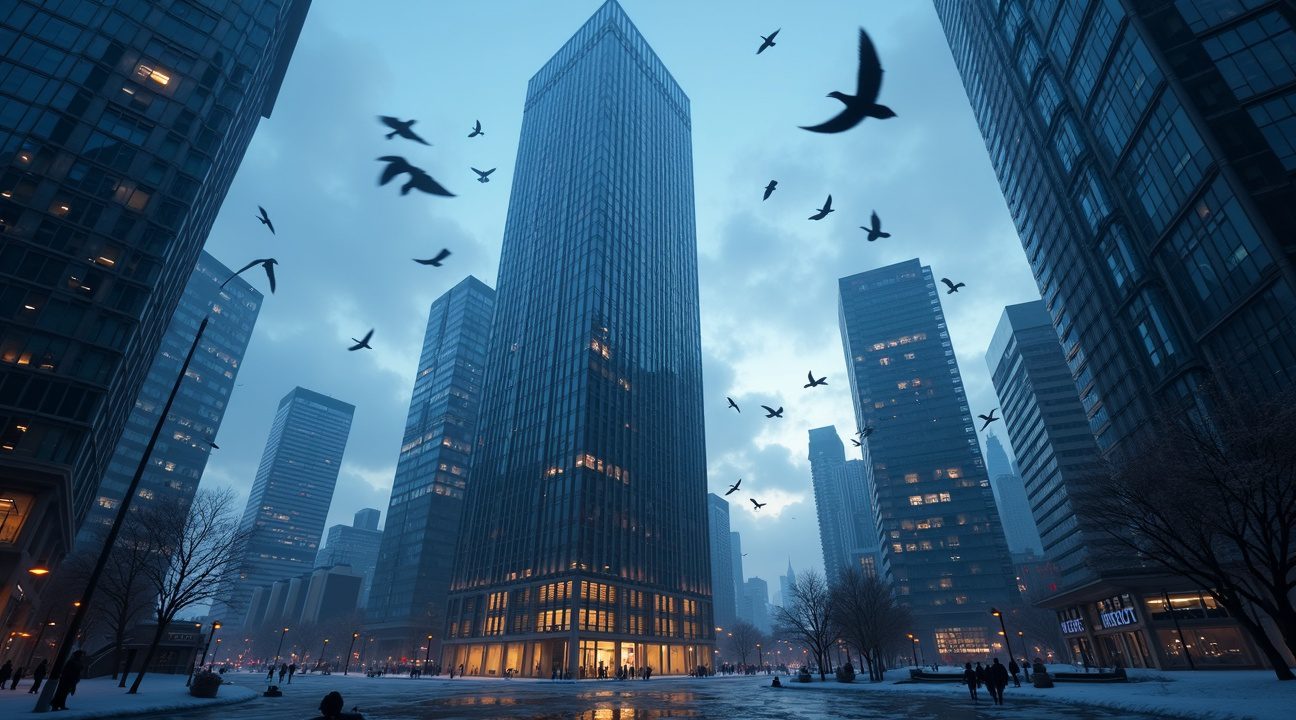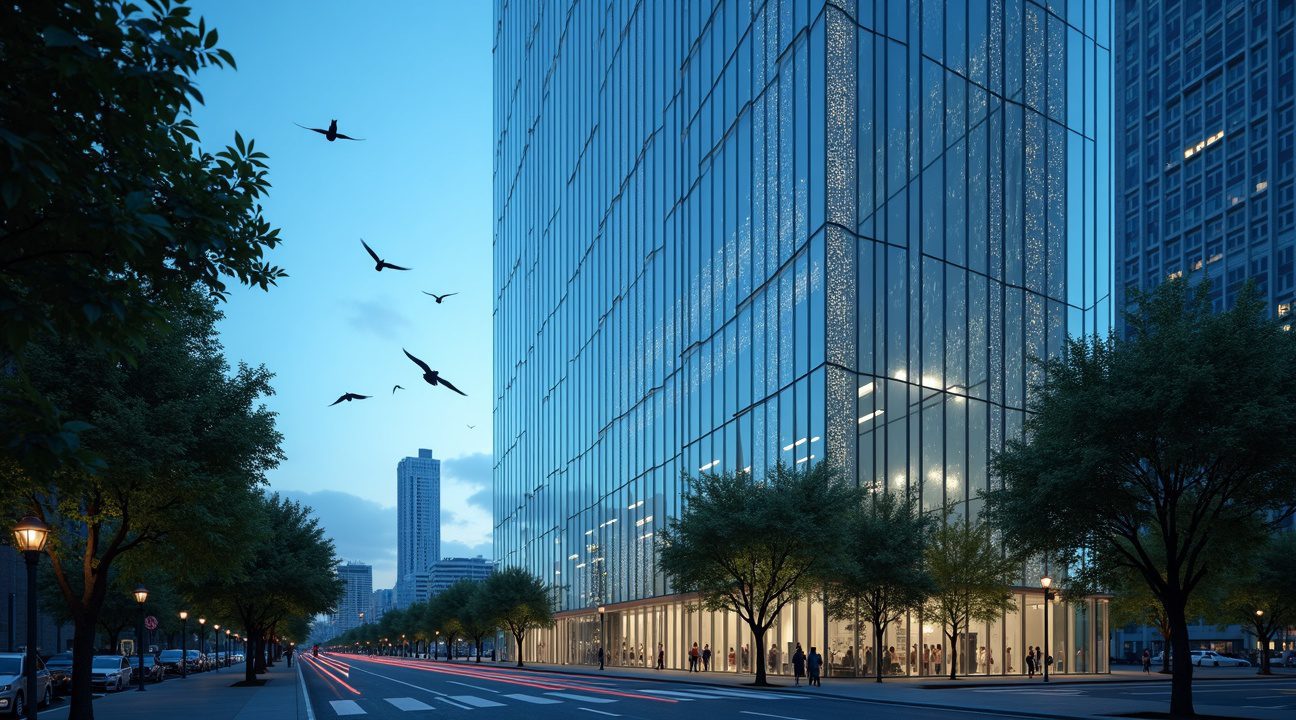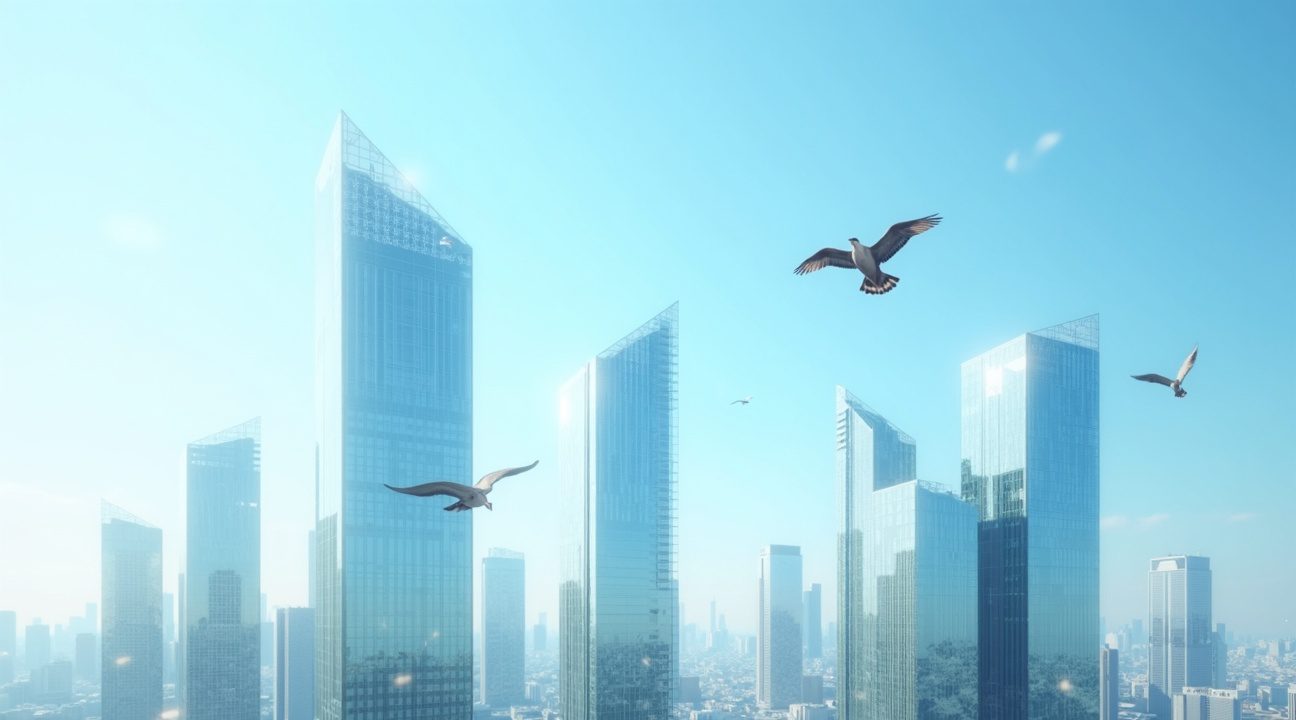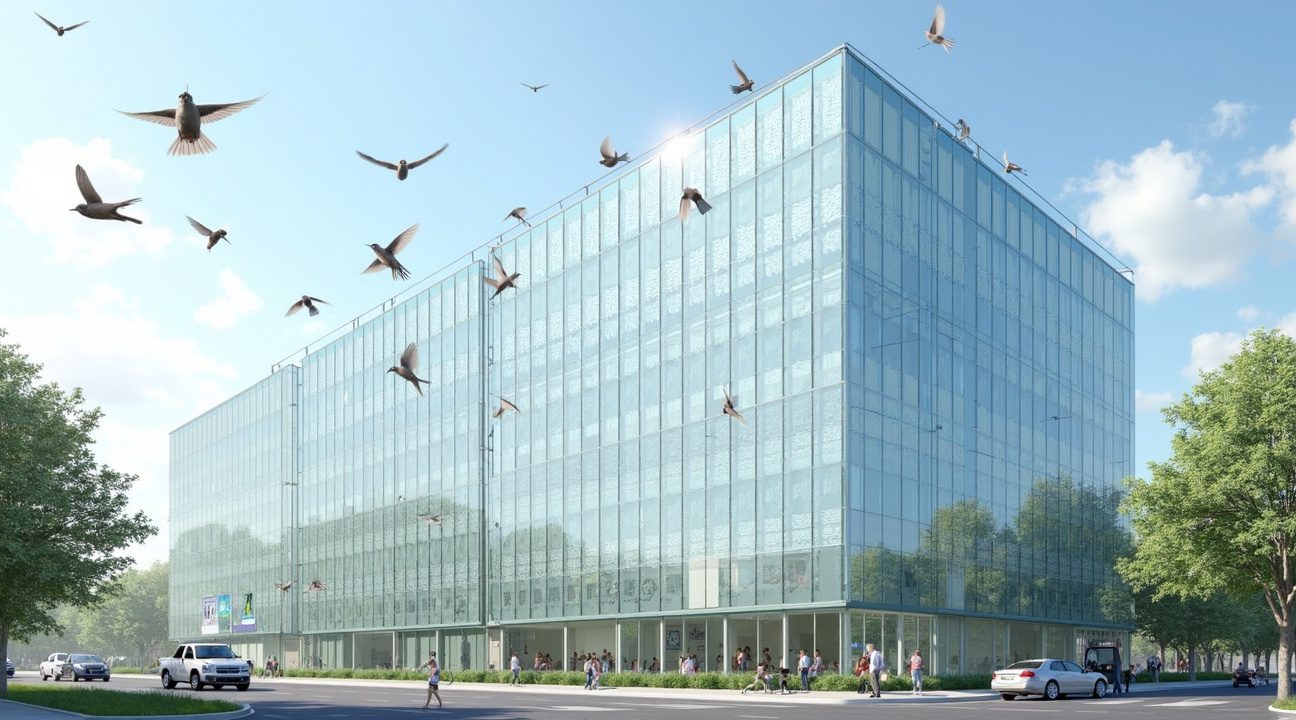Canada is actively combating a deadly bird collision crisis that claims the lives of up to 25 million birds each year by pioneering the use of UV-coated glass technology in architectural designs.
Innovative Use of UV-Coated Glass
The revolutionary UV-coating technology enables the creation of patterns visible to birds but invisible to the human eye. This innovation significantly reduces bird collisions with buildings without compromising modern architectural aesthetics. These patterns are effective in the 300–400 nm wavelength range, with at least 20–40% UV reflectance required to deter bird strikes.
Legal and Regulatory Evolution
A landmark legal case in 2013 set a new precedent by establishing corporate liability for bird deaths due to building facades. In response, Canada implemented comprehensive national guidelines and policies through the Canadian Standards Association A460 standard. This standard includes specific bird-protection requirements for commercial and residential buildings.
Critical Design Principles
The 2×2 Rule
One of the central tenets in bird-safe design is the 2×2 rule, which limits pattern spacing to no more than 2 inches horizontally by 4 inches vertically. Patterns are most effective when placed on the external surface of glass facades.
Required Compliance in Key Provinces
Several provinces—Ontario, Alberta, and British Columbia—now mandate the use of UV-patterned, bird-friendly glass in all new construction projects. These regional efforts have contributed to a broader nationwide shift toward wildlife-inclusive urban planning.
Leading Manufacturers and Industry Solutions
- Guardian Bird1st UV: Offers integrated UV-patterned laminated glass that earns LEED credits and prioritizes energy efficiency.
- Walker Glass AviProtek T: Specializes in etched optics and UV reflective coatings aimed at both commercial and institutional construction.
- Vitro BirdSmart: Produces a range of glass products combining bird safety features with thermal insulation.
Economic and Environmental Impact
In the long term, UV-coated glass installations offer greater value than temporary films. They lead to reduced maintenance costs, improved construction efficiency, and longer warranty periods. These factors contribute to both financial savings and enhanced environmental stewardship for developers and building owners alike.
Canada’s Bird Collision Crisis: 25 Million Deaths Annually Force Legal Action
Glass buildings across Canada have become deadly traps for migrating birds, creating an environmental crisis that kills up to 25 million birds annually. This staggering figure represents just the documented deaths in Canada alone, while billions more birds perish from building collisions throughout North America each year.
Urban Centers Bear the Heaviest Toll
Toronto and other major Canadian cities experience the most severe bird mortality rates due to their dense concentrations of glass-covered skyscrapers. Some individual buildings report hundreds of bird fatalities per year, with certain locations becoming notorious death traps during peak migration seasons. The reflective and transparent nature of modern architectural glass confuses birds, who can’t distinguish between sky reflections and actual flight paths.
High-rise buildings with extensive glass facades pose the greatest threat, particularly when they’re positioned along established migration corridors. During spring and fall migrations, exhausted birds flying at night become disoriented by building lights and crash into windows they cannot see. The problem intensifies in downtown cores where multiple tall buildings create canyon-like effects that funnel birds into collision zones.
Legal Precedent Changes the Landscape
A landmark 2013 legal case in Toronto established that companies can face prosecution under environmental law for bird deaths caused by their building designs. This precedent-setting decision found a Toronto company liable for avian mortality resulting from its glass facades, fundamentally shifting how developers and building owners view their responsibility for wildlife protection.
The ruling demonstrated that bird collisions aren’t merely unfortunate accidents but preventable incidents that can result in legal consequences. Environmental prosecutors successfully argued that companies have a duty to consider wildlife impacts when designing and maintaining their buildings. This legal framework has encouraged property owners to explore solutions like bird-friendly glass technologies that can reduce collision rates.
The decision also opened the door for increased enforcement of existing wildlife protection laws, making building owners more accountable for implementing bird-safe design features. Insurance companies have begun factoring potential bird collision liability into their risk assessments, further motivating property developers to adopt preventive measures.
Following this legal precedent, several other Canadian jurisdictions have strengthened their building codes to include bird-friendly design requirements. Toronto itself implemented mandatory bird-friendly design guidelines for new construction, requiring developers to use materials and design features that reduce bird collision risks. These regulations cover everything from glass specifications to lighting requirements, creating a comprehensive approach to reducing avian mortality.
The economic implications extend beyond legal liability, as building owners face:
- Potential fines
- Negative publicity
- Increased insurance costs
when their properties become known bird collision sites. Some facilities have reported spending thousands of dollars annually on bird carcass removal and cleanup, not including the potential costs of legal proceedings or regulatory penalties.
Conservation groups have leveraged this legal framework to advocate for stronger protective measures, pushing for expanded bird-friendly building requirements across all Canadian provinces. The precedent has also influenced how environmental impact assessments evaluate new construction projects, with bird collision potential becoming a standard consideration in the approval process.
This legal shift coincides with growing public awareness about urban wildlife conservation and the role that human-built environments play in species decline. Building owners who proactively address bird collision risks often find themselves recognized as environmental leaders, while those who ignore the issue face increasing scrutiny from both regulators and the public.
The combination of regulatory pressure, legal liability, and public awareness has created a powerful incentive structure for adopting bird-friendly building technologies. As the construction industry evolves to meet these new requirements, innovative solutions like patterned UV coatings on glass are becoming essential tools for reducing Canada’s devastating bird collision crisis.

Revolutionary UV Technology Makes Glass Visible to Birds While Remaining Invisible to Humans
Bird-friendly glass represents a groundbreaking advancement in architectural technology that addresses one of urban wildlife’s most pressing challenges. The innovation centers on specially engineered UV coatings that create patterns detectable to avian vision while maintaining complete transparency for human observers.
The science behind this technology leverages the fundamental differences between human and bird vision systems. Birds perceive ultraviolet light in the 300–400 nm wavelength range, a spectrum completely invisible to human eyes. This unique visual capability allows architects and building designers to implement protective measures without compromising aesthetic appeal or functionality.
UV Pattern Design and Surface Application Requirements
Effective bird-friendly glass incorporates specific pattern configurations that maximize visibility for flying wildlife. The most successful designs include:
- Horizontal or vertical stripes spaced at precise intervals
- Dot matrices with calculated density distributions
- Grid patterns that create clear visual barriers for birds
- Custom geometric designs that meet both safety and architectural standards
Professional installation requires applying these UV patterns to the outer surface, designated as Lite #1 in glazing terminology. This positioning ensures maximum effectiveness since birds approach buildings from the exterior environment. Interior applications prove significantly less effective because the UV signals become diffused through multiple glass layers.
Coverage specifications demand careful attention to both height and surface area requirements. The most critical zone extends from ground level to 12 meters above, where research indicates the majority of bird strikes occur. Within this vulnerable zone, UV patterns must cover at least 5% of the total glass surface to provide adequate visual warning signals.
Standard glass poses significant risks to bird populations due to its transparency and reflective properties. When natural habitats appear reflected in conventional building surfaces, birds become confused and attempt to fly through what appears to be open space. This illusion proves particularly dangerous during migration seasons when millions of birds traverse urban corridors.
The effectiveness threshold for bird-safe glass requires UV reflection levels between 20–40% in the critical 300–400 nm range. This specification ensures sufficient contrast for avian detection while maintaining the glass’s transparency for human vision. Testing laboratories use specialized equipment to measure these reflection values and certify compliance with bird safety standards.
Manufacturing processes for UV-coated glass involve precise application techniques that bond the protective patterns permanently to the glass surface. Unlike traditional etching or fritting methods that can compromise structural integrity, UV coatings maintain the glass’s original strength characteristics while adding the protective visual elements.
Building codes in numerous jurisdictions now mandate bird-friendly glass specifications for new construction projects. These regulations typically apply to buildings exceeding certain heights or those located near critical wildlife corridors. Architects must balance compliance requirements with design objectives, making UV technology an attractive solution that doesn’t sacrifice visual aesthetics.
The economic impact extends beyond initial installation costs, as building owners often discover reduced maintenance expenses related to cleaning and replacement of damaged glass panels. Additionally, many sustainable building certification programs now award points for implementing bird-friendly design elements.
Installation specialists emphasize proper handling and positioning during the glazing process. UV coatings require protection from certain cleaning chemicals and abrasive materials that could compromise their effectiveness over time. Maintenance protocols typically involve gentle cleaning solutions and soft-bristled tools to preserve the protective patterns.
Quality control measures include post-installation testing using UV photography equipment that verifies pattern visibility and coverage compliance. This documentation proves essential for meeting regulatory requirements and ensuring long-term performance of the bird safety systems.

Leading Canadian-Available Products Setting New Safety Standards
Guardian Bird1st UV stands out as a pioneering solution that combines nearly invisible protection with proven effectiveness. This innovative glass features a striped UV pattern that remains almost completely hidden from human view while creating a clear visual barrier for birds. The American Bird Conservancy has recognized its performance with an official Threat Factor score, confirming its ability to significantly reduce bird strikes. The product complies with the strict 2″ x 2″ rule established by bird safety guidelines and pairs seamlessly with SunGuard Low-E coatings to deliver both collision prevention and energy efficiency. Building professionals particularly value its contribution to LEED and Toronto Green Standard credits, making it an excellent choice for sustainable construction projects.
Top-Tier Solutions from Trusted Manufacturers
Walker Glass AviProtek T leverages Pilkington’s advanced UV coating technology combined with a specialized pyrolytic pattern to create exceptional bird visibility. Field testing has demonstrated the product’s high effectiveness in preventing collisions, while the patterns remain only faintly visible to humans under specific angles and lighting conditions. This subtle visibility ensures architectural aesthetics aren’t compromised while maintaining maximum bird safety.
Vitro BirdSmart Glass takes a different approach with laser-etched, first-surface markings that don’t rely on UV technology. The system offers various pattern options and integrates perfectly with Solarban low-e coatings, delivering combined energy performance and bird collision prevention. The American Bird Conservancy tunnel test has tested and approved this solution, providing architects and builders with verified performance data.
AGORA and VITRUM expand the available options with comprehensive bird-friendly product lines that include UV coatings, ceramic frit applications, and etched markers applied to the external glass layer. These manufacturers offer multiple pattern choices, allowing designers to select solutions that best match their specific project requirements. The variety of marking technologies available from these companies ensures that builders can find appropriate solutions regardless of their aesthetic preferences or performance specifications.
Each of these products represents significant advancement in bird-friendly building design, offering proven protection while maintaining the visual clarity and energy performance that modern construction demands. Similar to how NASA scientists find essential building blocks in space exploration, these manufacturers have identified the essential components needed for effective bird protection in urban environments.

Canadian Standards and Provincial Legislation Drive Nationwide Adoption
The Canadian Standards Association (CSA) A460 Bird Friendly Building Design establishes the foundation for bird-safe construction practices across Canada. This standard defines minimum requirements for both new and existing buildings, mandating specific UV patterning or physical markers that make glass surfaces visible to birds while remaining nearly invisible to human eyes.
Provincial governments have embraced these standards with comprehensive legislation. Ontario, Alberta, and British Columbia have all enacted bird-safe glass requirements for building projects, creating a regulatory framework that extends far beyond voluntary compliance. These provincial mandates ensure that developers must incorporate bird-friendly design elements into their construction plans, making UV-coated glass a standard consideration rather than an optional upgrade.
Municipal Leadership and Regional Expansion
Toronto emerged as an early pioneer in bird-safe building requirements, implementing regulations that other municipalities have since adopted. The city’s proactive approach demonstrated how local governments can effectively integrate bird safety into existing building codes without compromising architectural vision or construction timelines.
Similar legislation now exists across major US cities and states, reflecting a broader North American movement that positions Canada as a leader in this environmental initiative. Cities like San Francisco, New York, and Minneapolis have followed suit, creating a continental network of bird-friendly building standards that enhance migration corridor safety.
Bird-friendly glass installations offer significant advantages beyond regulatory compliance. These projects can earn valuable credits through LEED certification programs, where sustainable design elements contribute to overall building performance ratings. The Toronto Green Standard also recognizes bird-safe glass as a qualifying sustainability feature, providing developers with multiple pathways to achieve green building certifications.
Property owners discover that installing UV-patterned glass often qualifies for various municipal incentives and green building rebates. These financial benefits help offset initial installation costs while supporting broader environmental objectives. The integration of bird safety measures into established certification programs creates a win-win scenario where developers can meet regulatory requirements while advancing their sustainability goals.
I’ve observed that many architects and developers initially approach bird-friendly glass requirements as additional compliance hurdles. However, as innovative building solutions become more mainstream, these same professionals often discover that UV-coated glass opens new design possibilities rather than limiting creative expression.
The standardization of CSA A460 requirements across provincial jurisdictions has streamlined the specification process for construction teams working on multi-provincial projects. This consistency eliminates confusion about varying regional requirements and ensures that bird-friendly design principles remain consistent regardless of project location within Canada’s major metropolitan areas.
Technical Standards and Pattern Requirements for Maximum Effectiveness
The effectiveness of bird-friendly glass depends heavily on specific pattern dimensions and strategic placement. I’ve observed that proper implementation requires careful attention to both spacing requirements and surface application techniques to achieve optimal results.
Essential Spacing Requirements and the 2×2 Rule
Pattern spacing represents the most critical factor in bird-friendly glass effectiveness. The maximum allowable spacing should not exceed 2″ x 4″, but best practices recommend implementing the 2×2 rule for superior protection. This tighter spacing proves especially important for smaller species such as hummingbirds, which require more frequent visual cues to detect glass barriers effectively.
The 2×2 rule establishes a proven standard that significantly reduces bird strikes across all species sizes. Larger spacing intervals create dangerous gaps that birds attempt to fly through, leading to continued collisions even with patterned glass installed. External surface application enhances visibility and provides the strongest deterrent effect compared to internal placement options.
UV Coating Technology and Multi-Species Considerations
UV-reflective patterns offer an innovative solution that maintains human visibility while creating clear visual barriers for avian species. These coatings appear transparent to human eyes but reflect ultraviolet light that most birds can detect. However, avian perception varies significantly between species, making single-solution approaches less effective than comprehensive strategies.
Multi-faceted solutions combining UV coatings with physical etchings provide the greatest efficacy across diverse bird populations:
- Some species rely more heavily on UV detection.
- Others respond better to physical texture variations or contrasting patterns.
Combining these approaches ensures maximum protection regardless of individual species’ visual capabilities.
Glass transparency remains intact for human occupants when proper UV coatings are applied correctly. The patterns don’t interfere with natural lighting or architectural aesthetics while providing essential protection for wildlife. This balance makes UV-patterned glass an attractive option for both new construction and retrofit applications.
Pattern effectiveness correlates directly with consistent application and adherence to established spacing guidelines. External surface placement maximizes avian perception while maintaining the glass’s structural integrity and cleaning accessibility. Professional installation ensures patterns meet technical standards and deliver the intended protective benefits.
The combination of UV reflection technology with standardized spacing creates a comprehensive deterrent system. Birds approaching these treated surfaces receive multiple visual cues that help them recognize and avoid potential collision points. This layered approach addresses the varying visual capabilities found across different avian species.
Regular maintenance and pattern inspection help maintain long-term effectiveness:
- UV coatings can degrade over time due to weather exposure.
- Periodic assessment and potential reapplication are necessary.
- Maintenance schedules ensure continued protection and compliance with bird-friendly building standards.
Implementation success depends on selecting appropriate pattern types for specific building applications and local bird populations. High-rise structures in migration corridors benefit from more intensive patterning, while residential applications may require less comprehensive coverage. Understanding local avian behavior patterns helps determine optimal implementation strategies for each unique situation.

Testing Methods and Cost Analysis Reveal Long-Term Value
I’ve observed that comprehensive evaluation of bird-friendly glass requires rigorous field and tunnel testing protocols. Organizations like the American Bird Conservancy establish these testing standards to validate manufacturer claims about collision reduction effectiveness. These assessments generate a Threat Factor score on a 1-100 scale, where lower scores indicate superior bird safety performance.
Understanding Testing Limitations and Species-Specific Considerations
Testing reveals that UV-coated glass shows varying effectiveness across different bird species. I notice that some birds, including hummingbirds, pigeons, and certain birds of prey, don’t perceive UV wavelengths as strongly as other species. This limitation means UV patterns alone may not provide adequate protection for all avian visitors to urban environments.
Smart building designers often complement UV strategies with additional visual markers. Laser-etched or fritted patterns serve as backup collision deterrents, creating patterns visible across broader spectrums. These supplementary approaches ensure comprehensive protection regardless of individual species’ visual capabilities.
Cost analysis demonstrates that bird-friendly glass represents a strategic long-term investment. Initial expenses per square foot typically exceed those of after-market adhesive films, but permanent installation eliminates ongoing maintenance and replacement costs. Building owners appreciate that integrated glass solutions maintain regulatory compliance without periodic updates or reapplication procedures.
Surface application methods significantly impact both performance and durability. Factory-applied treatments integrate seamlessly with glass manufacturing processes, creating permanent collision-prevention features. These integrated solutions resist weathering, cleaning chemicals, and physical wear that often compromise temporary films or coatings.
Financial planning benefits from understanding the complete cost structure. While upfront expenses may appear higher, permanent installations avoid recurring labor costs associated with film replacement. Building maintenance teams don’t need specialized training for ongoing care, and warranty coverage typically extends much longer than temporary solutions.
I find that bird-smart testing protocols continue evolving as researchers gather more field data. Recent studies examine how different lighting conditions, seasonal variations, and urban canyon effects influence collision rates. This ongoing research helps architects and developers make informed decisions about which glass technologies provide optimal protection for their specific building locations.
Professional installers report that permanent bird-friendly glass also simplifies construction schedules. Teams can install these products during initial glazing phases rather than coordinating separate film application after building completion. This streamlined approach often reduces overall project timelines while ensuring compliance with emerging bird protection legislation.
The combination of rigorous testing standards and comprehensive cost analysis supports informed decision-making for building projects across Canada. Property developers increasingly recognize that investing in proven bird-friendly technologies protects both wildlife and long-term building value while meeting evolving environmental regulations.
Sources:
Guardian Glass, “Guardian Bird1st™ UV”
Audubon Magazine, “By Design: An Architectural Awakening Could Save Billions of Birds”
Vitro Glass Education Center, “Bird Vetted & Approved”
Walker Glass, “How Bird Safe Glass Can Save Millions of Birds”
Vitro Architectural Glass, “BirdSmart® Bird Safe Glass”
VITRUM™ Glass Group, “Bird Friendly Glass”
FLAP Canada, “Stop Birds from Hitting Windows”
AGNORA, “Bird Friendly Architectural Glass”
BirdSafe, “Bird-Safe Window Options”
FLAP Canada, “Cost of Bird-Friendly”


